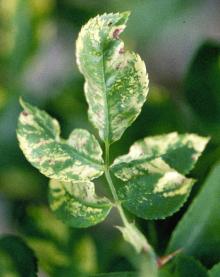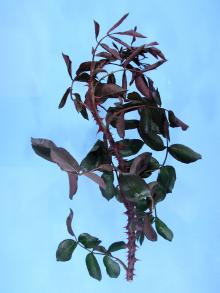See:
Rose (Rosa spp.) and hybrids - Rose Mosaic
Cause Several virus or virus-like diseases have been reported on the West Coast including rose mosaic, rose rosette virus, rose spring dwarf-associated virus, rose leaf curl virus, and rose yellow mosaic virus. Rose mosaic is the most common virus disease. All are easily transmitted through vegetative propagation techniques.
Rose rosette virus, transmitted by the eriophyoid mite, was used as a biocontrol for troublesome wild hedges of Rosa multiflora in the Midwest. It is now widespread east of the Rocky Mountains and has been found in California. Rarely found as a diagnosis in the PNW. All cultivated roses (shrub type, hybrid tea, floribunda, grandiflora and miniature roses) are thought to be susceptible to the disease. The 'Knock Out' rose cultivars are susceptible to rose rosette but just as much as other types.
Rose spring dwarf-associated virus has been found in aphids on affected plants but is not know if they are a vector of the disease or not.
Rose yellow mosaic virus (RoYMV) is a Potyvirus, which are known to be aphid-transmitted.
Symptoms Rose mosaic-chlorotic line patterns (zigzag pattern), ringspots, and mottles in leaves sometime in the growing season. There may also be yellow net and yellow mosaic symptoms.
Rose rosette-leaflet distortion and wrinkling, bright red leaf pigmentation, witches' broom, and phyllody. Plants are excessively thorny and eventually die. Infection can resemble glyphosate injury.
Rose spring dwarf-a rosetting or balling of new growth. Leaves are curved, very short, and show vein clearing or a netted pattern. Leaves occur on arrested shoots, which may not elongate for several months. Canes may grow in a zig-zag pattern during the growing season.
Rose leaf curl-spring leaves are small, leaflets detach easily, leaf epinasty, necrosis of shoot tips, and yellow vein flecking. Shoots are pointed with a broad base. Plants may recover in summer but show symptoms again in fall.
Symptoms associated with RoYMV infection included yellow mosaic, ring mosaic, premature leaf senescence, and necrotic dark-brown ring on canes. Symptoms first appeared in new growth 4 to 6 weeks post-inoculation. Necrotic cane symptoms were observed only in the cultivar Ballerina. Symptoms persist throughout the season.
Cultural control
- Purchase stock that is clean and/or certified as tested and free of all known viruses.
- Remove and destroy infected plants. Just removing symptomatic plant parts does not remove these viruses from the plant.
- Heat-treat scion stock plants 4 weeks at 100°F before grafting.
- Vector control has not always been successful.
References Druciarek, T., Lewandowski, M. and Tzanetakis, I. 2023. Identification of a second vector for rose rosette virus. Plant Disease, 107:2313-2315.
Lockhart, B., Zlesak, D., and Fetzer, J. 2008. Identification and partial characterization of six new viruses of cultivated roses in the USA. In XII International Symposium on Virus Diseases of Ornamental Plants. Acta Hortic 901:139-147.
Salem, N., Golino, D.A., Falk, B.W., and Rowhani, A. 2008. Identification and partial characterization of a new luteovirus associated with rose spring dwarf disease. Plant Disease 92:508-512.



